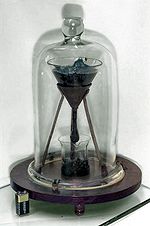The pitch drop experiment
 In one of the episodes of "I didn't know that", they featured what must be one of the most boring jobs of all time - watching paint dry. As it turns out, paint companies actually hire someone to check how fast their paint dries, comparing the results with various paints produced by the competition. This reminded me of a scientific experiment I found on the internet some time ago: the pitch drop experiment.
In one of the episodes of "I didn't know that", they featured what must be one of the most boring jobs of all time - watching paint dry. As it turns out, paint companies actually hire someone to check how fast their paint dries, comparing the results with various paints produced by the competition. This reminded me of a scientific experiment I found on the internet some time ago: the pitch drop experiment.
Pitch is a name given to any number of highly viscous liquids which appear solid, and this particular experiment measures the flow of one particular piece of pitch over the course of many, many years.
Professor Thomas Parnell (of the University of Queensland in Brisbane, Australia) started the experiment in 1927 in order to demonstrate to students that there are substances which can appear to be solid, but are in fact very-high-viscosity fluids.
The experiment in itself is very simple: a heated sample of pitch was poured in to a sealed funnel, and allowed to settle. Three years later(!), the seal at the neck of the funnel was cut, and the pitch started pouring out. Very, very slowly, droplets started to form and subsequently fall - each droplet took approximately a decade to fall. On the 28th of November 2000, the eighth drop fell, enabling the experimenters to calculate that pitch has a viscosity approximately 230 billion times that of water.
The pitch drop experiment is recorded in the Guinness Book of Records as the world's longest continuously running laboratory experiment, though there are other projects which have been running for far longer (for example the Beverly Clock, which has been running since 1864).
Over the years, not a lot has changed - in 1988 air conditioning was added to the location where the experiment resides, meaning the temperature now varies consistently, lengthening each drop's stretch before it eventually separates from the rest of the pitch left in the funnel.
By the way, if you have enough time on your hands, you can be the first to witness a pitch drop fall - to date, no one has ever witnessed a drop fall. To make life a little less complicated, you can save yourself a trip to the actual location, and follow the experiment via webcam.
Make sure you have enough coffee at hand, though... it's probably going to take a while.